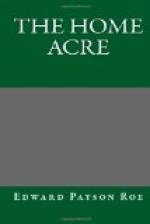Varieties.—Thompson in his English work names nineteen varieties with many synonyms; Henderson offers the seed of thirteen varieties; Gregory, of seventeen kinds. There is no need of our being confused by this latitude of choice. We find it in the great majority of fruits and vegetables offered by nurserymen and seedsmen. Each of the old varieties that have survived the test of years has certain good qualities which make it valuable, especially in certain localities. Many of the novelties in vegetables, as among fruits, will soon disappear; a few will take their place among the standard sorts. In the case of the kitchen, as well as in the fruit, garden, I shall give the opinion of men who have a celebrity as wide as the continent for actual experience, and modestly add occasionally some views of my own which are the result of observation.
As a choice for the home-garden, Mr. Henderson recommends the following varieties of onions: Extra Early Red, Yellow Globe Danvers, White Portugal or Silver Skin, and Southport Yellow Globe. Mr. Joseph Harris, the well-known and practical author: Yellow Danvers, Extra Early Large Bed, and White Globe. Mr. J. J. H. Gregory: New Queen, Early Yellow Acker, Yellow Danvers, Early Red Globe Danvers, Large Red Wethersfield. They all recommend onion sets. The Queen onion is quite distinct. For the home table, where earliness, as well as quality, size and quantity is desired, I think the Queen deserves a place. It is admirably fitted for pickling. I have tried all the varieties named, with good success, and grown some of the largest kinds to six inches in diameter.
CHAPTER IX
The kitchen-garden (concluded)
In the last chapter I dwelt somewhat at length on two vegetables for which thorough and enduring preparation is profitable. There is one other very early garden product which requires our attention during the first warm days of spring—rhubarb; sold in some instances under the name of “wine-plant.” Wine is made from the juicy stalks, but it is an unwholesome beverage. The people call rhubarb “pie-plant;” and this term suggests its best and most common use, although when cooked as if it were a fruit, it is very grateful at a season when we begin to crave the subacid in our food.
Its cultivation is very simple. Those who propose to produce it largely for market will find it to their advantage to raise this plant from the seed; but for the Home Acre enough plants can be procured, at a moderate cost, from almost any nurseryman. In this instance, also, thorough preparation of the soil is essential, for the rhubarb bed, under good care, will last eight or ten years. A rich, deep, clean, warm soil is the chief essential. It belongs to that class of vegetables known as “gross feeders.” During the first year, however, I would apply the fertiliser directly to the hills or plants. These




